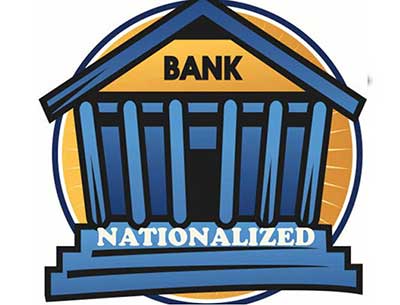Relevance: GS-3:Indian Economy and issues relating to Planning, Mobilisation of Resources, Growth, Development and Employment; Effects of Liberalisation on the Economy
Key Phrases: Budget 2022-23; SLR, CRR; 1969 Nationalisation of Banks; RBI Act 1934; better supervisory mechanisms of banks
Context
- Budget 2022-23 had proposed to privatise Government banks with the established economics rule of the west that a government has no business in staying in the business. It should limit its non-core activities and concentrate its energy on governance.
Key Highlights
- Recently, Well-known economist Arvind Panagariya, advocated that
the government must accelerate privatisation of public sector enterprises
and begin the process of privatisation of public sector banks.
- This move is being opposed by workers of the banks who are on constant strike mode
Why not to Privatise Banks?
- Policy of RBI - Banks cannot be run by industrial houses.
- This is done to avoid connected lending.
- Without the industrial houses in picture, no entities have the required financial capability to take over any of the government banks.
- Size of the Public banks - The market cap of State Bank of India
is $54.78 billion as on March 2022, and Bank of Baroda’s $7.04
billion.
- The market cap of all government banks is so huge that it will be difficult to find buyers for them.
- Banks mustn’t be treated as manufacturing or service industries due to
presence of checks and balances
- Banks are predominantly run using public funds by way of deposits; shareholders’ capital is generally small.
- To prevent banks from taking undue business risks using public money, there are checks and balances like Statutory Liquidity Reserve Ratio and Cash Reserve Ratio.
- These apart, they have to adhere to various regulations
regarding credit dispensation like
- Group exposure limits,
- Income recognition norms,
- Provision for bad debts, etc.
- Hence wholesale privatisation is not only undesirable but also dangerous as the public money is involved.
- A long history of private bank failures.
- From 1935 (Reserve Bank of India was established) to 1947, 900 bank failed in our country
- From 1947 to 1969, 665 banks failed.
- The depositors of all these banks lost their money.
- Government banks reduce bank failures
- Post Bank nationalisation (1969), only 36 banks have failed
- These were rescued by merging them with other government banks.
- This included even bigger banks like Global Trust Bank.
- Recently, Lakshmi Vilas Bank and YES Bank were rescued
- There were also many cooperative bank closures, and the strength of town cooperative banks have shrunk from 1,926 in 2004 to 1,551 in 2018.
- Post Bank nationalisation (1969), only 36 banks have failed
- Comfort to depositors
- Banks owned by the sovereign government provide a tremendous comfort level to depositors.
- The common man feels that a government bank cannot fail and his money is safe. Disturbing this structure will, therefore, be dangerous.
Importance of Bank Nationalisation
Government banks have contributed to the economic growth of the common man.
- Access to Credit - Only after nationalisation of banks could small borrowers get credit and there was a shift from class banking to mass banking.
- Availability of services in remote corners of the country - The nationalisation of private banks in 1969 resulted in the opening of tens of thousands of branches in remote corners of the country.
- Employment Opportunities - Job opportunities were created for a large section of educated youth. 42 crore ordinary people have opened bank accounts as a result of the immense contribution of state-owned banks in opening Jan Dhan Yojana accounts, a recent government initiative.
Private Banks can’t be compared with Government banks
- Private banks operate with the sole aim of adding shareholder value whereas Government banks also try to serve society and ensure implementation of all government programmes for the social sector.
Conclusion
- Performance should not be measured simply based on profitability or business handled but with the contribution to society, direct as well as indirect.
- The government must ensure better supervisory mechanisms of banks instead of attempting wholesale privatisation.
Source: The Hindu BL
Mains Question:
Q. Critically analyse the initiative of privatising government banks. Also suggest a suitable way forward.








